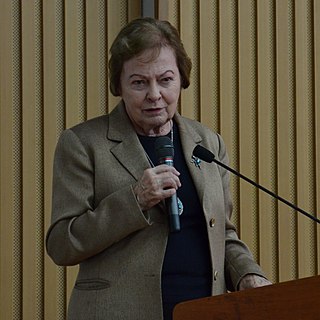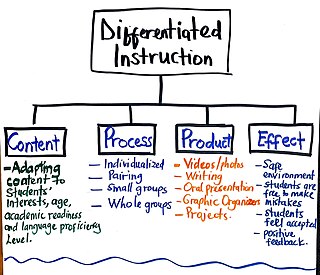Related Research Articles

Physical education, often abbreviated to Phys Ed. or P.E., is a subject taught in schools around the world. It is usually taught during primary and secondary education, and encourages psychomotor learning by using a play and movement exploration setting to promote health and physical fitness. Activities in P.E. include football, netball, hockey, rounders, cricket, four square, racing, and numerous other children's games. Physical education also teaches nutrition, healthy habits, and individuality of needs.

Pedagogy, most commonly understood as the approach to teaching, is the theory and practice of learning, and how this process influences, and is influenced by, the social, political and psychological development of learners. Pedagogy, taken as an academic discipline, is the study of how knowledge and skills are imparted in an educational context, and it considers the interactions that take place during learning. Both the theory and practice of pedagogy vary greatly, as they reflect different social, political, and cultural contexts.
Special education is the practice of educating students in a way that accommodates their individual differences, disabilities, and special needs. This involves the individually planned and systematically monitored arrangement of teaching procedures, adapted equipment and materials, and accessible settings. These interventions are designed to help individuals with special needs achieve a higher level of personal self-sufficiency and success in school and in their community, which may not be available if the student were only given access to a typical classroom education.
Blended learning, also known as hybrid learning, technology-mediated instruction, web-enhanced instruction, or mixed-mode instruction, is an approach to education that combines online educational materials and opportunities for interaction online with traditional place-based classroom methods.
Educational technology is the combined use of computer hardware, software, and educational theory and practice to facilitate learning. When referred to with its abbreviation, edtech, it is often referring to the industry of companies that create educational technology.

Inclusion in education refers to all students being able to access and gain equal opportunities to education and learning. It arose in the context of special education with an individualized education program or 504 plan, and is built on the notion that it is more effective for students with special needs to have the said mixed experience for them to be more successful in social interactions leading to further success in life. The philosophy behind the implementation of the inclusion model does not prioritize, but still provides for the utilization of special classrooms and special schools for the education of students with disabilities. Inclusive education models are brought into force by educational administrators with the intention of moving away from seclusion models of special education to the fullest extent practical, the idea being that it is to the social benefit of general education students and special education students alike, with the more able students serving as peer models and those less able serving as motivation for general education students to learn empathy.
Karen R. Harris is an American educational psychologist and special educator who has researched the development of learning strategies and self-regulation among students with learning challenges such as learning disabilities and attention deficit hyperactivity disorder. She is currently the Mary Emily Warner Professor in the Division of Educational Leadership and Innovation, Mary Lou Fulton Teachers College at Arizona State University.
English-Language Learner is a term used in some English-speaking countries such as the US and Canada to describe a person who is learning the English language and has a native language that is not English. Some educational advocates, especially in the United States, classify these students as non-native English speakers or emergent bilinguals. Various other terms are also used to refer to students who are not proficient in English, such as English as a Second Language (ESL), English as an Additional Language (EAL), limited English proficient (LEP), Culturally and Linguistically Diverse (CLD), non-native English speaker, bilingual students, heritage language, emergent bilingual, and language-minority students. The legal term that is used in federal legislation is 'limited English proficient'. The instruction and assessment of students, their cultural background, and the attitudes of classroom teachers towards ELLs have all been found to be factors in the achievement of these students. Several methods have been suggested to effectively teach ELLs, including integrating their home cultures into the classroom, involving them in language-appropriate content-area instruction early on, and integrating literature into their learning programs.
Formative assessment, formative evaluation, formative feedback, or assessment for learning, including diagnostic testing, is a range of formal and informal assessment procedures conducted by teachers during the learning process in order to modify teaching and learning activities to improve student attainment. The goal of a formative assessment is to monitor student learning to provide ongoing feedback that can help students identify their strengths and weaknesses and target areas that need work. It also helps faculty recognize where students are struggling and address problems immediately. It typically involves qualitative feedback for both student and teacher that focuses on the details of content and performance. It is commonly contrasted with summative assessment, which seeks to monitor educational outcomes, often for purposes of external accountability.

Nel Noddings is an American feminist, educator, and philosopher best known for her work in philosophy of education, educational theory, and ethics of care.
Developmentally appropriate practice is a perspective within early childhood education whereby a teacher or child caregiver nurtures a child's social/emotional, physical, and cognitive development. It is also described as a philosophy in child education that is based on child development knowledge where professionals base their instruction and care on research, standards, and recognized theory.
A paraprofessional educator, alternatively known as a paraeducator, para-pro, instructional assistant, educational assistant, teacher's aide or classroom assistant, is a teaching-related position within a school generally responsible for specialized or concentrated assistance for students in elementary and secondary schools.
A resource room is a separate, remedial classroom in a school where students with educational disabilities, such as specific learning disabilities, are given direct, specialized instruction and academic remediation and assistance with homework and related assignments as individuals or in groups.

Differentiated instruction and assessment, also known as differentiated learning or, in education, simply, differentiation, is a framework or philosophy for effective teaching that involves providing all students within their diverse classroom community of learners a range of different avenues for understanding new information in terms of: acquiring content; processing, constructing, or making sense of ideas; and developing teaching materials and assessment measures so that all students within a classroom can learn effectively, regardless of differences in their ability. Differentiated instruction, according to Carol Ann Tomlinson, is the process of "ensuring that what a student learns, how he or she learns it, and how the student demonstrates what he or she has learned is a match for that student's readiness level, interests, and preferred mode of learning." According to Boelens et al. (2018), differentiation can be on two different levels: the administration level and the classroom level. The administration level takes the socioeconomic status and gender of students into consideration. At the classroom level, differentiation revolves around content, processing, product, and effects. On the content level, teachers adapt what they are teaching to meet the needs of students. This can mean making content more challenging or simplified for students based on their levels. The process of learning can be differentiated as well. Teachers may choose to teach individually at a time, assign problems to small groups, partners or the whole group depending on the needs of the students. By differentiating product, teachers decide how students will present what they have learned. This may take the form of videos, graphic organizers, photo presentations, writing, and oral presentations. All these take place in a safe classroom environment where students feel respected and valued—effects.

A flipped classroom is an instructional strategy and a type of blended learning, which aims to increase student engagement and learning by having pupils complete readings at home and work on live problem-solving during class time. This pedagogical style moves activities, including those that may have traditionally been considered homework, into the classroom. With a flipped classroom, students watch online lectures, collaborate in online discussions, or carry out research at home, while actively engaging concepts in the classroom, with a mentor's guidance.

The term learning environment can refer to an educational approach, cultural context, or physical setting in which teaching and learning occur. The term is commonly used as a more definitive alternative to "classroom", but it typically refers to the context of educational philosophy or knowledge experienced by the student and may also encompass a variety of learning cultures—its presiding ethos and characteristics, how individuals interact, governing structures, and philosophy. In a societal sense, learning environment may refer to the culture of the population it serves and of their location. Learning environments are highly diverse in use, learning styles, organization, and educational institution. The culture and context of a place or organization includes such factors as a way of thinking, behaving, or working, also known as organizational culture. For a learning environment such as an educational institution, it also includes such factors as operational characteristics of the instructors, instructional group, or institution; the philosophy or knowledge experienced by the student and may also encompass a variety of learning cultures—its presiding ethos and characteristics, how individuals interact, governing structures, and philosophy in learning styles and pedagogies used; and the societal culture of where the learning is occurring. Although physical environments do not determine educational activities, there is evidence of a relationship between school settings and the activities that take place there.

Learning space or learning setting refers to a physical setting for a learning environment, a place in which teaching and learning occur. The term is commonly used as a more definitive alternative to "classroom," but it may also refer to an indoor or outdoor location, either actual or virtual. Learning spaces are highly diverse in use, learning styles, configuration, location, and educational institution. They support a variety of pedagogies, including quiet study, passive or active learning, kinesthetic or physical learning, vocational learning, experiential learning, and others.
Inclusive Classroom is a term used within American pedagogy to describe a classroom in which all students, irrespective of their abilities or skills, are welcomed holistically. It is built on the notion that being in a non-segregated classroom will better prepare special-needs students for later life. In the United States, the Rehabilitation Act of 1973 guaranteed civil rights to disabled people, though inclusion of disabled students progressed slowly until the No Child Left Behind Act of 2001, after which almost half of US students with disabilities were soon in general classrooms.
Julia Link Roberts is an American scholar of gifted education. In 2004, she was described as one of the fifty-five most influential people in the field. She is the Mahurin Professor of Gifted Studies at Western Kentucky University, and the executive director of The Center for Gifted Studies at Western Kentucky University and The Carol Martin Gatton Academy of Mathematics and Science in Kentucky.
Greta Morine-Dershimer is an American education researcher. She is Professor Emerita in the University of Virginia’s School of Education and Human Development. She has served as an officer of the American Educational Research Association, and is a former editor of Teaching and Teacher Education.
References
- ↑ McKee, Connor (2020). "Differentiation Techniques and Their Effectiveness for Video Game Art and Design Lectures in Higher Education". The Computer Games Journal. 9: 75–90. doi:10.1007/s40869-020-00096-3.
- ↑ "Former Warrenton student honors junior high teacher". Fauquier Now. October 29, 2015.
- ↑ Bender, William (2012). Differentiating Instruction for Students With Learning Disabilities: New Best Practices for General and Special Educators. Thousand Oaks, CA: Corwin Press. p. VII. ISBN 9781412998598.
- ↑ Ferlazzo, Larry. "Response: Ways to Differentiate Instruction for ELLs". Education Week - Classroom Q&A With Larry Ferlazzo. Retrieved 2019-08-09.
- ↑ http://www.kdsi.org Archived 2016-05-29 at the Wayback Machine
- ↑ "Dr. Carol Tomlinson,Invitations to Learn and Differentiated Instruction". Archived from the original on 2009-08-19. Retrieved 2009-03-25.